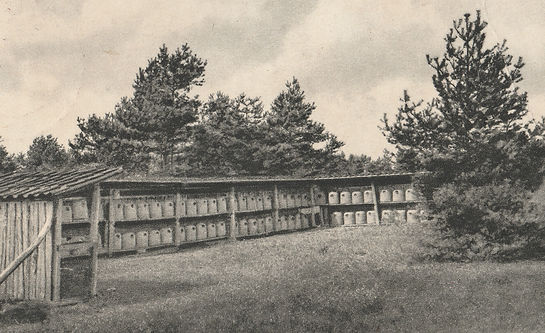Chapter 1:
The Geographic Area
This chapter is to provide the reader with an understanding of the geographical area that the Drewes clan left and how it has changed today.
The Luneburger Heide (moor or heath) in Germany is an expanse of sandy coastal moorlands between the cities of Hamburg and Hanover. The original vegetation (prior to 1500 AD) was a mixed forest of oak and beech trees. The forests were logged off in the Middle Ages to provide firewood for salt works. After the deforestation, juniper trees and heather, along with



gorse, broom, and blueberries took their place. A few remnants of oak, birch, and beech trees still remain. In the 20th century, pine forests were planted.
In this floral landscape, beekeeping became important. Not only was honey an important food source, the beeswax was used for candles and became another income source.

Beekeeping on the Heide
The other agricultural crop centered on the moorland sheep. The sheep are accustomed to a harsh and meagre diet of heather. They are part of the ecosystem as the heather must be

burned or grazed to rejuvenate itself. The grazing sheep do the job of fire. The way in which the sheep graze the heather is by “chomping” it. In German, the word “schnucken” is used to describe the chomping of the sheep. The sheep are called “heideschnucke.”
Sheep on the Heide
The Drewes Family came from the Heidmark, an area consisting of moorlands, woods, heaths and valley pastures. This area lies between Dorfmark, Fallingbostel, Wasrode, and Ahlden. The climate of the area is temperate Maritime, which features mild winters, cool summers and year-round rainfall.

Map showing 2 main towns, Fallingbostel and Dorfmark
Map from ______



In addition to the German language, a northern Low Saxon “Plattdeutsch” or Low German is commonly spoken there.
By the year 2000 AD, the area in which the family originated had devolved into two entities. The first part is a military training area called Hohne-Belsen and it is restricted to military personnel. The second part also used to be part of the military training reserve but it is now a nature reserve. The specific area that the Drewes family originated from is still in the Hohne-Belsen military training area.
A part of the Hohne-Belsen military training area was repatriated about 20 years after WWII in the 1970’s. At the time of repatriation, a controversial decision was made to not return this land to the original owners. Instead it was turned into nature parks. As a result, this area has become a popular tourist area and tourism is the most important business in the area. This area has also preserved some of the old farms (Hofs) and they form an important part of the tourist trap. Nature walking, hiking, biking and horse-drawn rides are all part of the aura of the area.
Some personal comments about the area: The Heide that I’ve seen currently (in the 21st century) is different than the pictures I have of the Heide 100 plus years ago. So I have included some of the old pictures as they were on postcards of that era.



For those who would like to see pictures of the original Hofs that the family departed from, I’ve included historic drawings and photographs. Because of their age I have to apologize for the quality. As for visiting in the current time, you can’t. The original area where the Drewes family lived in Obereinzingen is off limits as it is part of the Hohne Military Complex.




There are two tourist Drewes Hofs that are 20th century recreations. Drewes Hof Ferien Worlnugen is on the outskirts of Soltau. Hof Drewes Niedersachsen is in the Heide near the town of Hermansburg. The only original is Drewes Brummer Hof-Moide by Soltau. There is the possibility that the Drewes clan may have originated here give or take 300 to 500 years ago. The original is private and not available to tourists.

Drewes-Brummerhof Hoff near Solteu

Drewes-Brummerhof Hoff near Solteu

Brummerhof tourist buildings

Drewes-Brummerhof Hoff near Solteu
There are also severals Hofs related to other branches of the family. There is an original combined modern Hof owned by Heinrich Westerman by Bad Fallingbostel that appears to cater to tourists. The Wischoff Hof at Jetterbuch is still old style, and I think it is a private Wischoff residence. For the Kruse family, there is a bakery in Wietzendorf operated by Wilhelm and Erika Kruse.

Westermann Hoff near Fallingbostel in 2010

Westermann Hoff near Fallingbostel in 2010

Westermann Hoff near Fallingbostel in 2010

Westermann Hoff near Fallingbostel in 2010

Café run by Wilhelm and Erika Kruse near Wietsendorf

Wischoff Hoff near Jettebruch